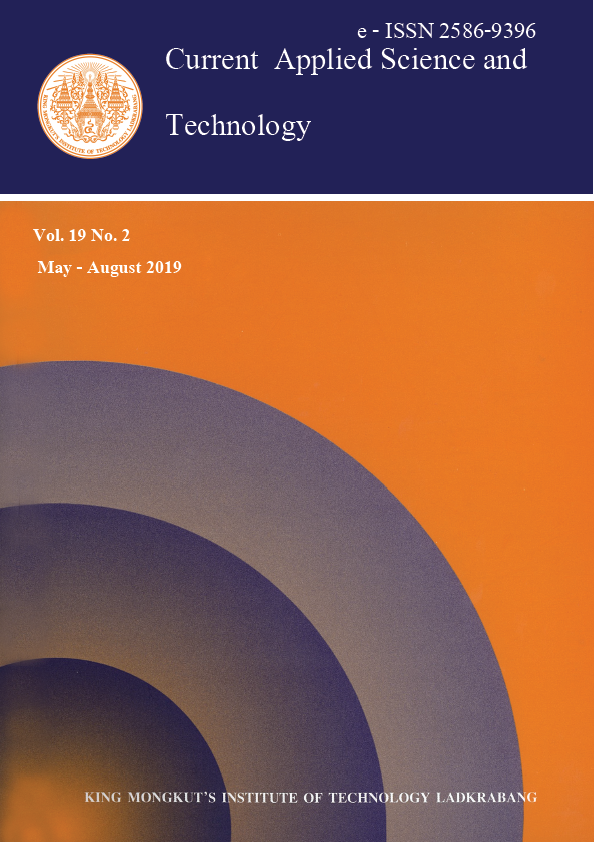Mathematical Model of Dengue Virus with Primary and Secondary Infection
Main Article Content
Abstract
In this study, we analyzed SEIR model for human and SEI model for mosquitoes. We considered the development of dengue infection from dengue fever (DF) to dengue hemorrhagic fever (DHF). The stability of the endemic equilibrium and the disease-free equilibrium states are incurred by Routh-Hurwitz criteria. Numerical simulations for the model are used to solve a system of differential equations. It showed that the local stability for disease free states and endemic states depended on the basic reproductive rate of the disease. The results of this study is recommended as an effective control measure for reducing the transmission of dengue disease.
Keywords: dengue fever; SEIR model; SEI model
*Corresponding author: Tel.: 662-329-8000 Ext. 6196 Fax: 662-329-8412
E-mail: kppuntan@kmitl.ac.th
Article Details
Copyright Transfer Statement
The copyright of this article is transferred to Current Applied Science and Technology journal with effect if and when the article is accepted for publication. The copyright transfer covers the exclusive right to reproduce and distribute the article, including reprints, translations, photographic reproductions, electronic form (offline, online) or any other reproductions of similar nature.
The author warrants that this contribution is original and that he/she has full power to make this grant. The author signs for and accepts responsibility for releasing this material on behalf of any and all co-authors.
Here is the link for download: Copyright transfer form.pdf
References
Bureau of Epidemiology, 2017. Department of Disease Control, Ministry of Public Health, Thailand. [online] Available at: http://www.boe.moph.go.th/fact/ Dengue_ Haemorrhagic_ Fever.htm
Hanson, J.L. and Fischer, P.R., 2017. Ready for Dengue in the United States? [online] Available at: https:// www.ahcmedia. com /articles/140960-ready-for-dengue-in-the-united-states
Wikipedia, 2017. Dengue Virus. [online] Available at: https://en.wikipedia.org/wiki/ Dengue_virus.
Structure of Dengue Virus, 2017. BioInteractive. [online] Available at: https://www.hhmi.org/biointeractive/structure-dengue-virus.
Immunization, Vaccines and Biologicals, Word Health Organization, 2017. [online] Available at: https://www.who.int/immunization/research/development/dengue_vaccines/en/.
Kongnuy, R. and Pongsumpun, P., 2010. Mathematical Modeling for Dengue Transmission with the Effect of Season. International Journal of Biological and Medical Sciences, 5(2), 74 -78.
Esteva, L. and Vargas, C., 1998. Analysis of a dengue disease transmission model. Mathematical Bioscience, 150, 131-151.
Sungchasit, R. and Pongsumpun, P., 2012. Dengue transmission model with the different incubation rate for each season. 1st Mae FahLuang University International Conference 2012, Chiangrai, 1-12.
Nikin, B.R. and Ciupe, S.M., 2017. Modelling original antigenic sin in dengue viral infection. Mathematical Medicine and Biology, 35(2), 1-16.
Pongsumpun, P. and Tang, I.M., 2003. A realistic age structured transmission model for dengue hemorrhagic fever in Thailand. Mathematical and Computer Modelling 32, 336-340.
Thavara, U., Tawastsin, A., Chansang C., Kong-ngamsuk, W., Paosriwong, S., Boon-Long, J., Rongsriyam, Y., Komalamisra, N., 2001. Larval occurrence, oviposition behavior and biting activity of potential mosquito vectors of dengue on Samui Island, Thailand. Journal of Vector Ecology, 26(2), 172-180.
World Health Organization, 2009. Dengue: Guidelines for Diagnosis, Treatment. Prevention and Control. Geneva: World Health Organization and the Special Programme for Research and Training in Tropical Diseases.
Guidance Clinical, 2017. Centers for Disease Control and Prevention. [online] Available at: https://www.cdc.gov/dengue/clinicallab/clinical.html.
Syafruddin, S. and Noorani, M., 2012. SEIR model for transmission of dengue fever in Selangor Malaysia. International Journal of Modern Physic: Conference Series, 9, 380- 389.
Kerdpanich, A., Watanaveeradej, V., Samakoses, R., Chumnanvanakij, S., Chulyamitporn, T., Sumeksri, P., Vuthiwong, C., Kounruang, C., Nisalak, A. and Endy, T., 2001. Perinatal dengue infection, Southeast Asian Journal of Tropical Medicine and Public Health, 32(3), 488-493.
Ferguson, N., Donnelly, C. and Anderson, R., 1999. Transmission dynamics and epidemiology of dengue: insights from age-stratified sero-prevalence surveys. Philosophical Transactions of the Royal Society London B. Biological Science, 354, 757-768.
Changal, K., Raina, A.B., Raina, A., Raina, M., Bashir, R., Latief, M., Mir, T. and Changal, Q., 2016. Differentiating secondary from primary dengue using IgG to IgM ratio in early dengue: an observational hospital based clinico-serological study from North India. BMC Infectious Diseases,16(1),715-721.
Guzman, M.G., Mayling, A. and Halstead, S.B., 2013. Secondary infection as a risk factor for dengue hemorrhagic fever/dengue shock syndrome: an historical perspective and role of antibody-dependent enhancement of infection. Archives of Virology, 158(7), 1445-1459.
Diekmann, D. and Heesterbeek, J., 2000. Mathematical Epidemiology of Infectious Disease: Model Building, Analysis and Interpretation. Chichester: John Wiley and Sons Ltd.
Adams, B., Holmes, E.C., Zhang, C., Mammen, M.P., Nimmannitya, S., Kalayanarooj S. and Boots, M., 2006. Cross-protective immunity can account for the alternating epidemic pattern of dengue virus serotypes circulating in Bangkok. Proceedings of the National Academy of Sciences, 103(38), 14234-14239.
Annual Epidemiological Surveillance Report, 1992-2012. Division of Epidemiology, Ministry of Public Health, Royal Thai Government.
Sungchasit, R., Pongsumpun, P. and Tang, I.M., 2015. SIR transmission model of dengue virus taking into account two species of mosquitoes and an age structure in the human population. American Journal of Applied Sciences, 12(6), 426-443.
Cheah, W.K., Ng, K.S., Marzilawati, A.-R. and Lum, L.C.S., 2014. A review of dengue research in Malaysia. Medical Journal of Malaysia, 69 (Supplement A), 59-67.
Pongsumpun, P. and Tang, I.M., 2003. Transmission of dengue hemorrhagic fever in an age structured population. Mathematical and Computer Modelling, 37, 949-961.
Omic, J. and Van Mieghe, P., 2016. Epidemic spreading in networks-variance of the number of infected nodes. [online] Available at: https://www.nas.ewi.tudelft.nl/people/ Piet/papers/VirusSpread_VarianceTUDReport20090707.pdf


